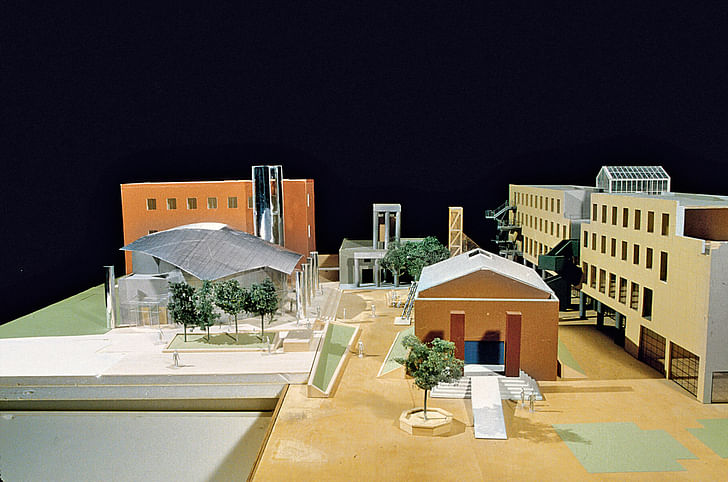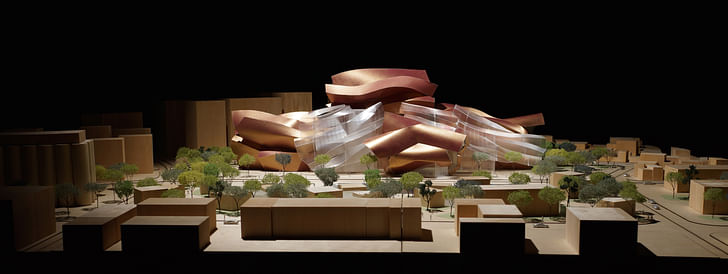

On September 13 of this year, Los Angeles will get its first major exhibition of Frank Gehry’s work, ever. Despite being the adopted hometown of the world-famous architect, and the city whose new-millennium architectural identity has been inflected most by his work, Los Angeles has not yet hosted a show exclusively on Gehry's retrospective.
On the completion of Gehry's Walt Disney Concert Hall in 2003, LA's Museum of Contemporary Art (MOCA) hosted a monographic exhibition of the architect's current works, focusing on the 10-12 projects currently in production in Gehry's office. Then there was the kerfuffle over 2013’s “New Sculpturalism” group show, also at MOCA, of which Gehry was to be a headliner, before he backed out citing creative differences with the style of the show’s representation. And there have been big Gehry-only shows at the Guggenheim in New York, the Philadelphia Museum of Art and the Walker Center in Minneapolis, but still no retrospective in Los Angeles. Now, the city is finally getting a Gehry exhibition worthy in scale and timeframe to the architect’s local impression – just, after its run in Paris.

The Pompidou wrapped up its “Frank Gehry” show this January, featuring over 60 of Gehry’s projects through 225 drawings and 65 models, and focused on two major conceptual threads: urbanism and digital design technologies. In those regards, exhibiting Gehry’s work poses a difficulty not common to most architectural shows – effectively communicating the evolving formal vocabulary of a living architect with over sixty years of experience, while also making software like CATIA straight-up accessible to thousands of daily visitors. Much of Gehry’s built work can be counted on to be recognizable to the average museum-goer; CATIA, not so much.“I think it would be disrespectful to take basically all the loans and basically create your own show. I don’t believe in doing that.”
From early on in the Pompidou show’s planning stages, Stephanie Barron, senior curator of Modern Art at LACMA, had been working with Pompidou curators Frédéric Migayrou and Aurélien Lemonier to bring the show to Los Angeles. The Pompidou show was widely well-received as the first major Gehry retrospective in Europe, and coincided with the opening of Gehry’s Fondation Louis Vuitton. While reproducing the show wholesale in Los Angeles wouldn’t be appropriate, its influence had to be respected. “I’d say that what we always talked about doing was taking the Paris show but then adding to it,” Barron told me. “I think it would be disrespectful to take basically all the loans and basically create your own show. I don’t believe in doing that.”

While the contents on display are mostly common to the Pompidou exhibition, LACMA’s show will include a selection of additional, newer models direct from Gehry’s office, of projects still being designed or currently under construction (including Facebook’s new campus and the renovation for the Philadelphia Museum of Art). There’s also the matter of explaining CATIA to a general audience, which was done through at the Pompidou through a video presentation produced by Gehry Technologies. The same video will also be presented in the LACMA show, but in a slightly different style.The two shows are in quite cozy company, both between their organizers and their subject
So if the contents are mostly identical, the major distinguishing factors shift towards setting and exhibition design. And in both cases, that has been shaped largely by Gehry himself. The two shows are in quite cozy company, both between their organizers and their subject: Gehry worked closely with co-curators Migayrou and Lemonier on the Pompidou exhibition’s design, and the LACMA exhibition will be designed fully under his name – the latest installment in an historied working relationship between Gehry and LACMA that began in the 1960s. Gehry has designed eleven exhibitions for LACMA since, including the very successful “Degenerate Art” (1991) on the avant-garde in Nazi Germany, and the architecturally-inflected “Calder and Abstraction” (2013) on Alexander Calder’s mobiles and stabiles. He has collaborated with Barron on exhibitions at LACMA for thirty-five years, although this will be the first featuring his own work.


does it compromise an exhibition’s critical integrity if the creator of its contents also handles its design?Which raises an interesting question: does it compromise an exhibition’s critical integrity if the creator of its contents also handles its design? Not that major exhibitions of living starchitects are prone to criticality in general, but celebrity-driven exhibitions (such as LACMA’s recent shows featuring Tim Burton and Stanley Kubrick) can easily toe the line of fawning fandom. Christopher Hawthorne hinted at such in his Los Angeles Times review of the Pompidou show, referring to the imminent Barron and Gehry collaboration in LACMA’s exhibition. There’s also the matter of LACMA’s (hopeful) institutional collaboration with Gehry: the museum’s director, Michael Govan, has expressed interest for Gehry to design a new tower on museum property, grounded by a new architecture and design extension to the museum, and perhaps even including Gehry’s archive that the museum has also been eyeing.
Hawthorne’s major criticism of the Pompidou show is that it puts Gehry’s work too much behind glass – both literally and figuratively. There’s an antiseptic quality to the show that keeps engagement at an arm’s length “with restraint and politesse”, as Hawthorne puts it, ignoring any thornier socio-political issues that Gehry’s office might have encountered in its many decades of practice. This comes off less as a derisive comment and more as a missed opportunity to really give Gehry his due – Hawthorne draws attention to excluded bits like his office’s hiring of a human-rights lawyer to oversee construction at the Guggenheim, which sheds an empathetic light on Gehry’s work in regards to a whole host of pressing contemporary architectural issues, as well as providing a defense angle for work that’s been commonly criticized for imposing itself on its site.

This all isn’t necessarily surprising: “Monographic shows of this kind often tiptoe around touchy subjects, edging in the worst cases toward hagiography,” states Hawthorne in his Pompidou review. The Architectural Review’s take on the Pompidou exhibit cuts to the quick in this regard, referencing Gehry’s press conference bird-flipping in October of last year (a few weeks after the Pompidou show opened) as a sign that despite his architectural stature, he’s still “very thin-skinned”. The critic almost seems impatient for Gehry to, ahem, exit architecture, so that the audience can “get a less polished and more probing picture of his legacy”.
Given Gehry’s even stickier attachment to LACMA’s show, it’s unlikely that things will be more critical than in Paris – but at least, they’ll be arranged differently. The Pompidou doesn’t have a space devoted to architecture (yet – the museum announced in November of 2014 that an The critic almost seems impatient for Gehry to, ahem, exit architecture, so that the audience can “get a less polished and more probing picture of his legacy”.“architecture and design” gallery space would be added in the current Renzo Piano and Richard Rogers building), but it was able to situate the Gehry exhibition within an approximate urban setting, “soberly displayed in the ground-floor Galerie Sud, whose floor-to-ceiling glazing allows views of the surrounding city”, according to the Architectural Review. The LACMA show will take place on the museum’s Resnick Pavilion, the portion of LACMA also designed by Renzo Piano, which affords a fair amount more breathing room to the exhibition than what could be arranged at the Pompidou.

Pulling on her experience working with Gehry on prior exhibition designs, Stephanie Barron dismissed the possibility that, in light of Gehry’s celebrity, the exhibition would smack of starchitectural pomp: “He’s most interested in letting the material speak for itself, as opposed to imposing some architectural, authorial voice, and I think the same thing is true here. The idea is to let the material unfold to the visitor, not walk in and say “Wow, I’m in a Gehry space”. That’s not what I think really good exhibition design does. Good exhibition design is about supporting the material, not about shouting out who the designer is.”

And regardless of how you feel about Gehry, or even how familiar you are with his architecture, the LACMA show will be undeniably relatable for anyone in Los Angeles. You’d be hard pressed in this city (and the county’s interwoven constituent cities) to find someone who hasn’t noticed the Hall’s flickering reflection pass over their windshield while driving past, or oriented themselves by looking for the giant glinting metal curves on the horizon, let alone attended a concert inside or gathered at adjacent Grand Park. And lest we forget, Gehry has been on The Simpsons. For Barron, this Gehry show’s homecoming is past its due: “I think it’s about time to show the full breadth of his imagination and practice to now a more sophisticated and highly interested Los Angeles audience.”
"Frank Gehry" will be at LACMA September 13, 2015 through March 20, 2016.
Update: A previous version of this article failed to mention MOCA's 2003-2004 monographic exhibition, "Frank O. Gehry: Work in Progress", as an example of how Gehry's work had been exhibited before in Los Angeles, but at a smaller scale than LACMA's upcoming "Frank Gehry".
Former Managing Editor and Podcast Co-Producer for Archinect. I write, go to the movies, walk around and listen to the radio. My interests revolve around cognitive urban theory, psycholinguistics and food.Currently freelancing. Be in touch through longhyphen@gmail.com
3 Comments
Looks cool, much to be learned from the older, pre jerk off work.
[biting my tongue]
Looks interesting.
Re criticality: It's inherently difficult to create a critical exhibit on a living architect. The situation is different than that of living artists, whose works themselves are the focus of an exhibit and can be sourced directly from owners without explicit cooperation of the artist. Architectural exhibits often depend on process material owned by the architects, so need to be sensitive to how they depict the architect. So long as that relationship is openly stated I think there's no intellectual-ethical dilemma. Certainly a very large volume of architecture shows like the Venice Biennale are directly curated by the architects involved, and indirectly are self-promoting.
I think as architects we're often too cynical to appreciate the value of an in-depth engagement with established successes; as if professional success itself was a reflection of impure motives. It's worth taking a focused look at the familiar to try to reconsider your own understanding of an approach to architecture.
Block this user
Are you sure you want to block this user and hide all related comments throughout the site?
Archinect
This is your first comment on Archinect. Your comment will be visible once approved.